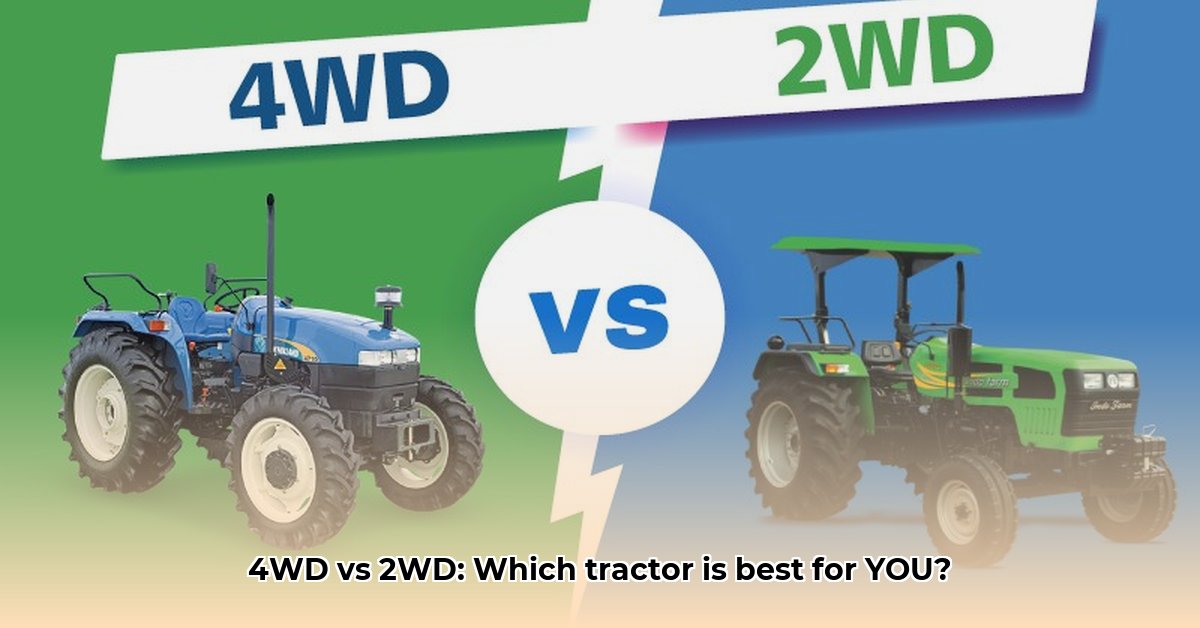
Choosing the Right Tractor for Your Sustainable Farm
Choosing between a two-wheel-drive (2WD) and a four-wheel-drive (4WD) tractor is a crucial decision for any farmer committed to sustainable agriculture. This guide provides a step-by-step framework to help you make the best choice for your specific needs and farming practices. The right tractor maximizes efficiency, minimizes environmental impact, and preserves profitability for years to come. Understanding the tractor's PTO is also important; learn more about it here.
Understanding Your Farm's Needs: Terrain and Operations
Before considering specific tractor models, thoroughly assess your farm's characteristics. Two key factors heavily influence your decision: terrain and operational requirements.
Terrain: Do you primarily farm flat, well-drained fields, or do you navigate hilly, uneven land? Hilly terrain significantly benefits from the superior traction and stability of a 4WD tractor. This minimizes wheel slippage, reducing fuel consumption and soil compaction compared to a 2WD tractor. Flat terrains, however, will find a 2WD tractor sufficient and more economical.
Operations: What are your primary farming tasks? Heavy-duty operations like tilling, hauling, or working in wet conditions demand the power of a 4WD tractor. Lighter tasks, such as precise planting or maneuvering in tight spaces, often benefit from the maneuverability of a 2WD. Consider the scale of your operations; A large farm might require a 4WD tractor or even multiple tractors for efficiency. A smaller farm could find a 2WD tractor perfectly adequate.
Is your farm size a critical consideration? The scale of your operations influences the type of tractor that is most practical and cost-effective.
Assessing Costs: Initial Investment and Long-Term Expenses
The initial purchase price of a 4WD tractor is significantly higher than that of a 2WD tractor. However, the long-term cost-effectiveness of each must be carefully analyzed. While 2WD tractors typically offer lower fuel consumption per hour, this alone does not tell the entire story. Consider the following factors:
Fuel Efficiency: 2WD tractors generally consume less fuel per hour than their 4WD counterparts. However, the enhanced traction of a 4WD often translates to less fuel wasted on wheel slippage, especially in challenging terrain. “Careful fuel monitoring and recording of field operations are crucial for accurate comparison of fuel efficiency in different terrains,” states Dr. Emily Carter, Agricultural Engineer at the University of California, Davis.
Maintenance and Repairs: 2WD tractors are typically simpler in design, leading to lower maintenance and repair costs compared to 4WD tractors. More complex 4WD machinery may require more frequent and potentially more expensive servicing.
Lifespan: The operational lifespan of a tractor hinges on consistent maintenance and usage patterns irrespective of the drive type. However, consistent operation under challenging conditions can wear out components faster.
A comprehensive long-term cost analysis, accounting for these factors, is crucial for making an informed decision. Consider the total cost of ownership over five to ten years, factoring in fuel, maintenance, repairs, and potential downtime.
Soil Health and Environmental Impact: Minimizing Compaction
Soil compaction significantly impacts soil health and long-term sustainability. 4WD tractors, due to their increased weight and power, present a higher risk of soil compaction if not carefully managed. This compaction reduces water infiltration, hinders root growth, and negatively affects crop yield. Appropriate tire pressure and reduced tillage techniques are crucial for mitigating compaction risks with any tractor type, especially 4WD. 2WD models, being lighter, generally pose less risk but are not without impact.
Did you know that soil compaction can reduce crop yields by up to 20%? Proper tractor selection and operation are vital for sustainable practices.
The choice between 2WD and 4WD tractors often reveals a trade-off between initial cost and long-term sustainability. While 2WD tractors provide lower initial cost and fuel consumption per hour, their performance in challenging conditions and their potential for soil compaction must be carefully weighed against the higher purchase price and operating costs of a 4WD tractor.
A Step-by-Step Decision-Making Framework
- Assess Your Terrain: Carefully evaluate your farmland's topography. Hilly or uneven terrain strongly favors a 4WD tractor. Flat land may allow for the use of a 2WD.
- Define Your Operational Needs: List your most frequent agricultural tasks. Heavy-duty operations need the power of 4WD, while lighter tasks can be handled by a 2WD.
- Establish a Realistic Budget: Determine your financial resources. Factor in both the initial purchase price and long-term costs including fuel, maintenance, and repairs.
- Prioritize Soil Health: Consider the potential for soil compaction. 4WD tractors, while offering greater capabilities, pose a higher risk of compaction if not used and managed with care.
- Conduct a Long-Term Cost Analysis: Estimate total ownership costs over the tractors' expected lifespan, integrating purchase price, fuel consumption, and maintenance expenses. This helps determine true value.
Different Stakeholders, Different Needs
The ideal tractor choice varies considerably between different stakeholders:
| Stakeholder | Primary Considerations | Likely Tractor Choice |
|---|---|---|
| Small-Scale Farmer | Budget, manageable terrain, essential tasks | Possibly a used 2WD or a smaller, affordable 4WD |
| Large-Scale Farmer | Efficiency, soil health, productivity, large-scale operations | Likely a 4WD, possibly multiple tractors |
| Government Agency | Environmental impact, fuel efficiency, farm support programs | Support for fuel-efficient tractors and sustainable practices |
| Tractor Manufacturer | Innovation in fuel efficiency, soil conservation, technological advancements | Development and promotion of hybrid and alternative-fuel systems |
Sustainable farming practices require careful consideration of all factors. This guide provides a framework for such consideration. Remember that ongoing research and evolving technologies will continue to shape the tractor market, influencing the decision-making process in the future.